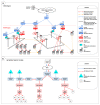Towards an Efficient Method for Large-Scale Wi-SUN-Enabled AMI Network Planning
- PMID: 36501807
- PMCID: PMC9740512
- DOI: 10.3390/s22239105
Towards an Efficient Method for Large-Scale Wi-SUN-Enabled AMI Network Planning
Abstract
In a smart grid communication network, positioning key devices (routers and gateways) is an NP-Hard problem as the number of candidate topologies grows exponentially according to the number of poles and smart meters. The different terrain profiles impose distinct communication losses between a smart meter and a key device position. Additionally, the communication topology must consider the position of previously installed distribution automation devices (DAs) to support the power grid remote operation. We introduce the heuristic method AIDA (AI-driven AMI network planning with DA-based information and a link-specific propagation model) to evaluate the connectivity condition between the meters and key devices. It also uses the link-received power calculated for the edges of a Minimum Spanning Tree to propose a simplified multihop analysis. The AIDA method proposes a balance between complexity and efficiency, eliminating the need for empirical terrain characterization. Using a spanning tree to characterize the connectivity topology between meters and routers, we suggest a heuristic approach capable of alleviating complexity and facilitating scalability. In our research, the interest is in proposing a method for positioning communication devices that presents a good trade-off between network coverage and the number of communication devices. The existing literature explores the theme by presenting different techniques for ideal device placement. Still rare are the references that meticulously explore real large-scale scenarios or the communication feasibility between meters and key devices, considering the detailed topography between the devices. The main contributions of this work include: (1) The presentation of an efficient AMI planning method with a large-scale focus; (2) The use of a propagation model that does not depend on an empirical terrain classification; and (3) The use of a heuristic approach based on a spanning tree, capable of evaluating a smaller number of connections and, even so, proposing a topology that uses fewer router and gateway positions compared to an approach that makes general terrain classification. Experiments in four real large-scale scenarios, totaling over 230,000 smart meters, demonstrate that AIDA can efficiently provide high-quality connectivity demanding a reduced number of devices. Additional experiments comparing AIDA's detailed terrain-based propagation model to the Erceg-SUI Path Loss model suggest that AIDA can reach the smart meter's coverage with a fewer router positions.
Keywords: AMI network planning; key device positioning; smart grid communication network.
Conflict of interest statement
The authors declare no conflict of interest.
Figures











References
-
- Afework B., Boechler E., Hanania J., Stenhouse K., Suarez L.V., Donev J. Energy Education—Electrical Grid [Online] 2021. [(accessed on 8 May 2022)]. Available online: https://energyeducation.ca/encyclopedia/Electrical_grid.
-
- Bush S.F., Goel S., Simard G. IEEE Vision for Smart Grid Communications: 2030 and beyond Roadmap. IEEE; New York, NY, USA: 2013. pp. 1–19. - DOI
-
- Kornatka M., Popławski T. Advanced Metering Infrastructure—Towards a Reliable Network. Energies. 2021;14:5986. doi: 10.3390/en14185986. - DOI
MeSH terms
Grants and funding
LinkOut - more resources
Full Text Sources
Miscellaneous

